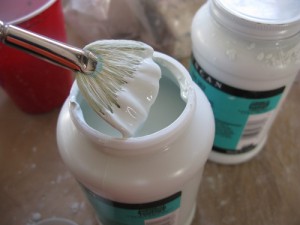Applications of CMC in the Ceramic Glaze
- Adhesion Effects
The adhesion of CMC in the slurry is shown by the firm network structure formed by the macromolecules or the macromolecules depending on the hydrogen bonds and van der Waals forces. When water penetrates inside the CMC gum blocks, the part with less hydrophilic groups will produce swelling, while the part with more hydrophilic groups will immediately separate from gum blocks after swelling. Since the hydrophilic groups are not uniform in the production of CMC, then the dispersed particle sizes of micelles are inconsistent. The inside of the micelles will be in hydration swelling, while the outside will be combined with a layer of hydrates, i.e., the bound water layer. In the early stage of dissolution, the micelles are free in the colloid. Due to the asymmetry of size and shape, and regularly moving closer to each other by van der Waals forces, the bound water layer gradually forms the reticular structure. Since CMC is fibrous, the network structure formed has a larger volume, so has stronger adhesion ability, and can reduce the glazed defects.
- Suspension Effects
Without the addition of additives, the glaze slurry will produce precipitation over time due to gravity. When preparing glaze, even adding a certain amount of clay can not significantly prevent precipitation. However, after adding a certain amount of CMC, it forms the reticular structure, supports the gravity of glaze molecules, and the molecules or ions of CMC extend in the glaze and occupy a certain space, preventing the mutual contact of glaze molecule microparticles, improving the dimensional stability, in particular increasing the suspending property of glaze slurry by the repulsion between the negatively charged CMC anions and negatively charged clay particles, so CMC has very good suspending property used in the glaze slurry.
- Problems Concerned In the Selection of CMC
1). When purchasing, see clearly the models and specifications and select the specifications of CMC suitable for the production.
2). When glaze materials are loaded into the mill, add CMC at the same time, which helps to improve the milling efficiency. In order to achieve the maximum efficiency, when pouring water, it should be noted that ingredients: water = 1%: 0.5% is appropriate.
3). It is best for the glaze to be rotted for one or two days, so that the glaze slurry can be sufficiently stable and CMC can play the best results.
4). The addition amount of CMC should make appropriate adjustment with the changes of seasons, the maximum in summer, the minimum in winter and between the two in spring and autumn. Generally the variation range is between 0.05% and 0.1%. If it remains unchanged in winter, then it will cause the flow glaze, dry slowly and lead to the sticky glaze. Conversely, if the amount is insufficient, it cannot achieve the dense and smooth glazed surface. As the temperature is high in summer, and CMC will get degraded when the viscosity is affected by bacteria, so in summer it is necessary to do well in anti-corrosion work and add suitable additives.
5). In use, the glaze is best to be sieved with the sieve over 100 meshes, so that the residues of CMC will not affect the glazed surface during the firing.

